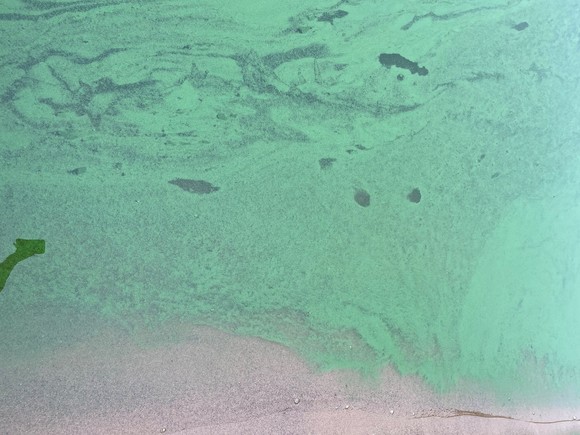
The 2022 Harmful Algal Bloom (HAB) Illness Season in Review
"Habby" 2023! A big thanks to all our partners at the local, state, and federal level for their assistance with investigating and responding to HAB-related illnesses in 2022. This newsletter contains a case summary and highlights from the 2022 season.
How the HAB program investigates health complaints
When our HAB program receives a health complaint, we gather information from the complainant by administering a standardized questionnaire and review the information provided to determine the likelihood that the reported illness is related to exposure to cyanobacteria (also known as blue-green algae). We gather information on the nature of the exposure, the environmental conditions observed at the time of exposure, symptoms experienced (including time-to-symptom onset), and health history. Our investigation often includes working with our partners at the Department of Natural Resources to review available photos and satellite imagery of the water conditions at the time of the exposure. In some cases, we may collect and test water samples of the implicated water body to determine levels of cyanobacteria and their toxins, called cyanotoxins.
Complaint summary
In 2022, we received 25 human and three animal illness complaints from people who thought the illnesses could be from HAB exposure. After thorough investigation of these complaints, we concluded that 10 human illnesses and two animal illnesses were potentially related to HAB toxicity. These cases had reported exposure to cyanobacteria in water bodies located in Walworth, Calumet, St. Croix, Walworth, Polk, Racine, Barron, and Chippewa counties.
 |
|
Human cases |
Human cases occurred in both children and adults ranging from ages 3 to 47 years. Cases experienced vomiting, diarrhea, coughing, congestion, and skin rashes. The likely routes of exposure included ingesting, inhaling, and coming into skin contact with water that contained cyanobacteria and/or cyanotoxins.
Two human illness reports were associated with a HAB-related illness outbreak. The outbreak occurred among two summer camp counselors who were exposed to bloom-affected water and developed allergic reactions including a rash. Our HAB program worked with the camp to investigate these illnesses and institute measures to prevent additional exposures from happening. One of the resources we shared was a Staying Safe at the Lake: What Summer Camps Should Know about the Blue-Green Algae fact sheet.
What's the scoop on cyanobacteria and skin?
We received more reports of skin conditions possibly related to cyanobacterial exposure in 2021–2022 than in previous years. Here's what we've learned about how HABs can affect the skin:
- People with sensitive skin, allergies, or skin conditions may be more susceptible to dermal reactions caused by exposure to cyanobacteria or cyanotoxins.
- Rashes can occur where clothing is held tightly against skin, like under swimsuits and waistbands. Cyanobacterial cells can get caught between skin and clothing, break open, and release toxins which can result in skin injury.
- Cyanobacteria and cyanotoxins do not get absorbed into the skin and into the body, so symptoms beyond skin irritation would not be likely after coming into contact with affected waters.
A foot rash that is suspected to be from prolonged exposure to cyanobacterial scum.
 |
|
Dog cases
|
Two illnesses in dogs were thought to be associated with HAB exposure. Symptoms of one dog included diarrhea, vomiting, and coughing. The other dog experienced a seizure and sought follow-up care from its family veterinarian and an emergency veterinarian. It is possible that both dogs ingested or inhaled water from a lake experiencing a bloom and developed gastrointestinal, respiratory, and neurologic symptoms as a result.
Illnesses in dogs are often ruled out because a cause of illness other than blue-green algae poisoning is more likely or confirmed by a veterinarian. Other common causes of illness in dogs include heat related-stress, water intoxication, pesticide exposure, and exposure to other poisonous substances. Learn more about how to protect your dog by visiting our Blue-Green Algae and Dog Safety fact sheet.
2022 Bloom Photo of the Year
The bloom pictured below was observed last July in the St. Croix River. The photo shows planktonic (microscopic free-floating) cyanobacteria. The genera Microcystis and Aphanizomenon were both present on the river but cannot be distinguished from each other in this photo. A closer look would reveal “grass clipping” Aphanizomenon colonies and irregular blobs of Microcystis. Accumulations of these cyanobacteria were reported during calm weather conditions and when wind was pushing the floating colonies to the shore.

 |
|
Let's Get Social! |
This issue’s sample post:
It’s not too late to make a New Year’s resolution! Now’s the perfect time to start thinking about how you can keep Wisconsin’s lakes clean and healthy this summer. Learn what you can do to help prevent harmful algal blooms by visiting our Keeping Our Lakes Clean webpage.
 |
|
Missed a past issue? Previous issues are available on our Resources for Health Professionals webpage.
Email us (dhsdphhabs@wi.gov) your burning questions! If others can benefit from hearing the answer to your question, we’ll feature it in a future issue.
Remember that we are always available for consultation on any HAB health-related issue by email or phone (608-266-1120).
|
|